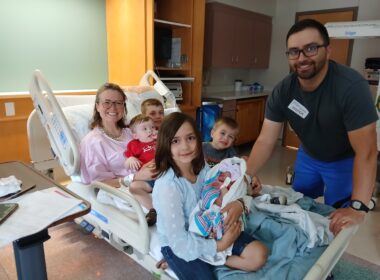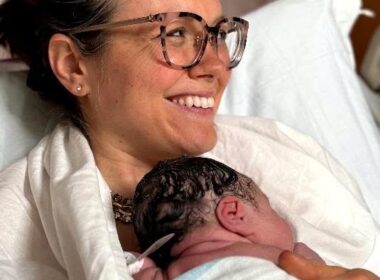“How long have you been trying to conceive?” the woman asked me over the phone. At the time, I was a military spouse, and had called Walter Reed National Military Medical Center to schedule an appointment with my assigned primary care doctor, specifically so I could get a referral for infertility care—without which, we’d have to pay for treatment ourselves.
“Six months,” I said, and immediately regretted it.
“Well, I’m sorry, but your doctor won’t be able to refer you for infertility treatment, because you’re under 35 and haven’t been trying for a year, yet.”
“But,” I immediately responded, “I’ve been charting my cycles, and we’ve been having intercourse timed to my fertile window. Statistically, I should be pregnant by now.” But the cat was already out of the bag: I’d said six months, and I was under 35. Tricare (the military health insurance we had at the time) and its standard of care algorithm would neither make a referral for, nor cover the costs of, the infertility care I already knew we needed.
I was flustered, but not surprised. Even as a 23-year-old newlywed, I was used to the idea that the standard of care for women’s reproductive health did not follow the science of the woman’s cycle. For that, I would have to go directly to a NaProTechnology doctor, or a doctor trained in some other form of Restorative Reproductive Medicine (RRM).
Even as a 23-year-old newlywed, I was used to the idea that the standard of care for women’s reproductive health did not follow the science of the woman’s cycle. For that, I would have to go directly to a NaProTechnology doctor, or a doctor trained in some other form of Restorative Reproductive Medicine (RRM).
Restorative Reproductive Medicine (RRM) is finally in the news–but can you trust what you read about it?
Once a niche form of care few women (and doctors) had heard of, Восстановительная репродуктивная медицина (ВРМ) has recently been in the news more than ever before, largely because of statements made by the American College of Obstetricians and Gynecologists (ACOG), and the American Society for Reproductive Medicine (ASRM).
Over the past few months, both professional organizations have released statements, briefs, Instagram posts and/or fact sheets asserting that RRM is a “nonmedical and nonpatient-centered approach” which “establish[es] barriers to evidence-based fertility care,” and stating that RRM is a “rebranding of standard medical practice” that “excludes IVF and related treatments on moral or religious grounds, not clinical evidence.” In a June 27 Instagram post, ACOG even stated: “‘Restorative reproductive medicine’ may be portrayed as a promising approach, but it can delay or block access to proven infertility treatments. Patients deserve science-backed options to build their families."
But ASRM’s and ACOG’s full-court press against RRM is distinctly at odds with the growing number of thriving RRM practices and clinics across the country, and the lived experiences of women, like myself, who have been successfully treated by RRM-trained professionals to overcome reproductive disorders, infertility, and more. One look at the nearly 400 comments on ACOG’s aforementioned Instagram post, the vast majority of which detail personal RRM success stories (whether treatment resulted in healthy pregnancies or improved reproductive health and quality of life), tells us that ASRM’s and ACOG’s statements aren’t telling anything close to the truth.
ASRM’s and ACOG’s full-court press against RRM is distinctly at odds with the growing number of thriving RRM practices and clinics across the country, and the lived experiences of women, like myself, who have been successfully treated by RRM-trained professionals to overcome reproductive disorders, infertility, and more.
My experience with algorithmic vs. patient-centered, cycle-based infertility care
About three months after that disappointing call with the Walter Reed appointment scheduler, and through a strange twist of fate, I found myself sitting in the office of a new primary care doctor–this time, on the island of Guam. Trained as he was in RRM, Dr. Burke did not require me to endure three more anguished months of trying and failing to get pregnant to take my concerns, my PMS symptoms, and my heavy and painful periods seriously. Instead, he knew the underlying science of the female menstrual cycle, he trusted that with more than a year of charting my cycles with a fertility awareness method (FAM) that I знал my body, and he could see that my charts reflected the reality that something, indeed, was wrong.
So we dove immediately into a series of lifestyle changes, vitamin and mineral supplementation, targeted blood draws to assess hormone levels (and then targeted, bioidentical hormonal supplementation), all of which not only improved my heavy, painful cycles, but made me feel healthier overall. Physical exams of my husband and myself, semen analysis, imaging studies of my uterus, ovaries, and fallopian tubes, and continued FAM charting through it all, provided us with further pieces to our infertility puzzle.
About five or six months after my first appointment with Dr. Burke, my cycles were clearly improving, and I felt healthier than ever, but we still hadn’t conceived. We were just beginning to discuss the possible next step of exploratory surgery for endometriosis, when we finally conceived for the very first time. To our great sorrow, I miscarried that child at 8 weeks gestation, while on vacation in California.
We were shocked at the 1-week post-miscarriage follow-up appointment at the hospital where I miscarried, when, after only being asked how long we’d been trying to conceive (about 15 months, by that time), I was promptly offered IVF by the OB/GYN. Buoyed by the improvements in my health we’d seen over the past several months, and the fact that the RRM approach was clearly working—I’d finally conceived for the first time когда-либо, after all!—we staunchly refused his offer.
Fortunately, back from vacation and armed with a new hormonal protocol, I conceived a child the very next cycle, who eventually grew into a healthy seven-and-a-half pound baby boy, born at 38 weeks. About a year later, my healthy cycles returned– but thankfully, my fertility issues never have. I have since gone on to have three additional, healthy, full-term babies, only utilizing bioidentical progesterone support early on in each pregnancy. We have also successfully used FAM (and the detailed knowledge and understanding of my health and fertility that it gives us) to intentionally space each pregnancy until the time of our choosing.
So, what это RRM?
According to the website of the Международный институт восстановительной репродуктивной медицины (IIRRM): “Restorative reproductive medicine (RRM) is a specialized field of medicine that focuses on identifying the underlying health conditions that contribute to reproductive dysfunction and suboptimal reproductive health, treating them to restore the natural functions of the reproductive system.
“Unlike conventional approaches that use treatments that suppress normal physiology to deal with dysfunction, RRM seeks to work with the body, treating reproductive abnormalities, not by bypassing the body’s processes but by diagnosing, understanding, and addressing underlying health concerns. This approach improves overall wellness and restores reproductive abilities such as fertility.”
A hallmark of RRM is the utilization of detailed FAM charts, which provide women with a keen understanding of their cycles and fertility for both health and family planning. In the hands of a RRM-trained physician, a FAM chart can be as informative as an EKG tracing is in the hands of a cardiologist.
A hallmark of RRM is the utilization of detailed FAM charts, which provide women with a keen understanding of their cycles and fertility for both health and family planning. In the hands of a RRM-trained physician, a FAM chart can be as informative as an EKG tracing is in the hands of a cardiologist.
The power of FAM + RRM
My personal experience is an excellent example of the power of the FAM + RRM approach in helping women achieve optimized cycles for health and fertility. When women are taught to read the signs of our cycles via FAM–that is, to become truly body literate–we can become educated, empowered, and informed advocates for our reproductive health, who accept nothing less than real answers and root cause solutions that protect, preserve, and/or restore our fertility.
When women are taught to read the signs of our cycles via FAM–that is, to become truly body literate–we can become educated, empowered, and informed advocates for our reproductive health, who accept nothing less than real answers and root cause solutions that protect, preserve, and/or restore our fertility.
My story likewise helps illuminate the differences between the “standard medical practice” (to borrow ASRM’s phrase) and restorative reproductive medicine. Standard obstetrics and gynecology would have put me on birth control for my painful periods (when I wanted to avoid pregnancy), to then later refer me to IVF after a year of unsuccessfully trying to get pregnant. (This is the story many women have to share, including Shannon Leach, ARNP, who now advocates powerfully for the RRM approach to reproductive health on her Instagram, и through the organization FACTS.)
RRM trained professionals, on the other hand, take seriously that a woman’s cycle is a fifth vital sign of her health, and that infertility is often a симптом of an underlying issue with one’s cycle. (Importantly, male factor infertility is also explored, evaluated, and treated–and RRM has restorative andrology protocols for that, too).
С сайта cutting-edge surgical techniques for endometriosis, PCOS, and fibroids, to targeted hormonal support, to addressing nutrition and lifestyle changes and more, RRM-trained healthcare professionals are not only following the science of fertility, but taking a patient-centered approach that has improved the lives of countless women and couples across the country.
С сайта cutting-edge surgical techniques for endometriosis, PCOS, and fibroids, to targeted hormonal support, to addressing nutrition and lifestyle changes and more, RRM-trained healthcare professionals are not only following the science of fertility, but taking a patient-centered approach that has improved the lives of countless women and couples across the country.
Madeleine Kearns’s NaPro success story in Свободная пресса
One recent example of RRM’s incredible impact came from Madeleine Kearns, an associate editor at Свободная пресса, who recently wrote about her own struggles with (and eventual healing from) endometriosis and infertility in her piece, “What I Went Through to Meet My Daughter.” By focusing on her experience at Veritas Fertility & Surgery (a NaProTechnology-based practice in St. Louis, MO), and through weaving in the stories of other women and couples who also found hope and healing at Veritas, Madeleine demonstrated that NaProTechnology is, without a doubt, doing что-то outside “standard medical practice.”
When interviewing Valerie, a fellow patient at Veritas who had previously undergone IVF on the difference between the two experiences, Madeleine noted:
“The most important thing, [Valerie] said, was that Veritas focused on restoring her health, whereas IVF felt like bullying her body into submission.
‘NaPro requires an understanding that your body isn’t a machine, and you can’t just force it to do something and that it has to heal and that takes time and patience,’ Valerie said.”
“‘NaPro requires an understanding that your body isn’t a machine, and you can’t just force it to do something and that it has to heal and that takes time and patience,’ Valerie said.”
The promise of NaPro is something we’ve long written about here at Natural Womanhood, especially for its ability to identify and treat underlying causes of fertility issues, rather than suppress or circumvent them via birth control or IVF. And as infertility rates skyrocket, and more couples than ever before are encouraged towards IVF, IUI, and other forms of assisted reproductive technology (ART), it’s critical to continue raising awareness of the root-cause approach to treating reproductive disorders and infertility that is RRM.
Importantly, as other forms of RRM, like FEMM и NeoFertility, also become better-known and more accessible, RRM is no longer limited to NaProTechnology–although NaPro’s pioneering reproductive surgical techniques (used to great effect by physicians such as Dr. Gavin Puthoff at Veritas, Dr. Patrick Yeung at the RESTORE Center for Endometriosis, и Dr. Naomi Whittaker of RRM Academy, among others) remain unparalleled.
The crucial difference between RRM and IVF
Again, while ASRM claims that “Reproductive Health Care–Including IVF–Is Inherently Restorative and Ethical,” patients like Valerie, Shannon Leach, and Mamta (whose story we featured here), have seen firsthand that IVF does not see infertility for what it truly is: a симптом of an underlying issue, rather than a disease in itself. IVF therefore does nothing to restore one’s good health and fertility. In fact, it may often do the exact opposite, as it relies instead upon circumventing issues like PCOS, эндометриоз, и tubal factor infertility, rather than treating them (and does so despite the fact that women with these conditions are less likely to have successful IVF cycles, and that IVF may actually make these underlying disorders хуже).
Importantly, as Dr. Leonora Butau, PhD, wrote in her 2022 Natural Womanhood article, “Когда ЭКО не удается, что делать дальше?:"
“Even if IVF leads to a successful live birth, the root causes of infertility often go unresolved, and in many cases, are left undiagnosed. In the event that IVF treatment fails, not only do women and couples suffer the pain of a failed cycle, but they are no better off health-wise, and many times, the reason for failure is not understood.”
In the same article, Dr. Butau further noted:
“Professor Robert Winston, a British infertility expert, has argued that, strictly speaking, IVF is not a ‘treatment’ for infertility, as it does not address or resolve the underlying causes of infertility. Significantly, he has asserted that ‘more than half of the women referred to IVF clinics would be better served by alternatives’ and has underlined that doctors are failing to diagnose the root causes of infertility and are using IVF as a ‘blanket treatment’ [6].”
IVF is neither the only nor the best way to overcome infertility
My story, Madeleine’s story, the stories of the women featured in her Free Press article, and the stories of multiple women we’ve featured at Natural Womanhood over the past several years are part of a growing chorus of voices praising RRM as the effective, affordable, restorative approach to women’s health and fertility. As millions of women suffer needlessly from endometriosis and other reproductive issues, and as infertility leaves countless couples heartbroken and longing for children of their own, these stories are critical to raising awareness of, and helping other couples demand access to, the truly cutting-edge approach to care that is RRM.
Despite ASRM and ACOG’s insistence to the contrary, RRM is not only the best, but the только truly patient-centered approach to authentically treating infertility available to women and couples today. The growing number of voices singing RRM’s praises based on lived experience are now too loud to possibly ignore. But the question remains: Will ACOG and ASRM listen?
🔗 Read more about restorative reproductive medicine on the Natural Womanhood website:
- Истории ЭКО и восстановительной репродуктивной медицины: Что у них общего и чем они отличаются
- Доступная и эффективная альтернатива ЭКО, о которой никто не говорит
- 3 проблемы репродуктивного здоровья, которые технология NaProTechnology решает лучше, чем альтернативные варианты
- Необъяснимое бесплодие не всегда необъяснимо
- Когда ЭКО не удается, что делать дальше?
- Истории ЭКО и восстановительной репродуктивной медицины: Что у них общего и чем они отличаются
- Как восстановительная репродуктивная медицина помогает решить распространенные гинекологические проблемы лучше, чем противозачаточные средства
- NW Podcast S4Ep1: NeoFertility has entered the chat: A conversation with Dr. Monica Minjeur
🔗 Learn the truth about IVF on the Natural Womanhood website:
- NW Podcast Ep. 8: Почему этот бывший лучший врач по ЭКО теперь предлагает только восстановительную репродуктивную медицину: Интервью с доктором Лорен Рубал, доктором медицинских наук.
- Темная сторона индустрии ЭКО от выжившего
- Скрытые расходы на ЭКО: боль в сердце, риск для здоровья и беспомощность
- Все виды ЭКО сопряжены с риском, но один из них, в частности, несет в себе значительный риск развития преэклампсии. Какой из них выбрать и почему?
- Assisted reproductive technology (ART), heart disease, and stroke: What’s the connection?
- Естественное зачатие после ЭКО может быть более распространенным явлением, чем многие думают
- Повышает ли ЭКО риск мертворождения?
📢 Share this article with a friend or family member who needs to learn more about the root-cause approach to treating infertility







